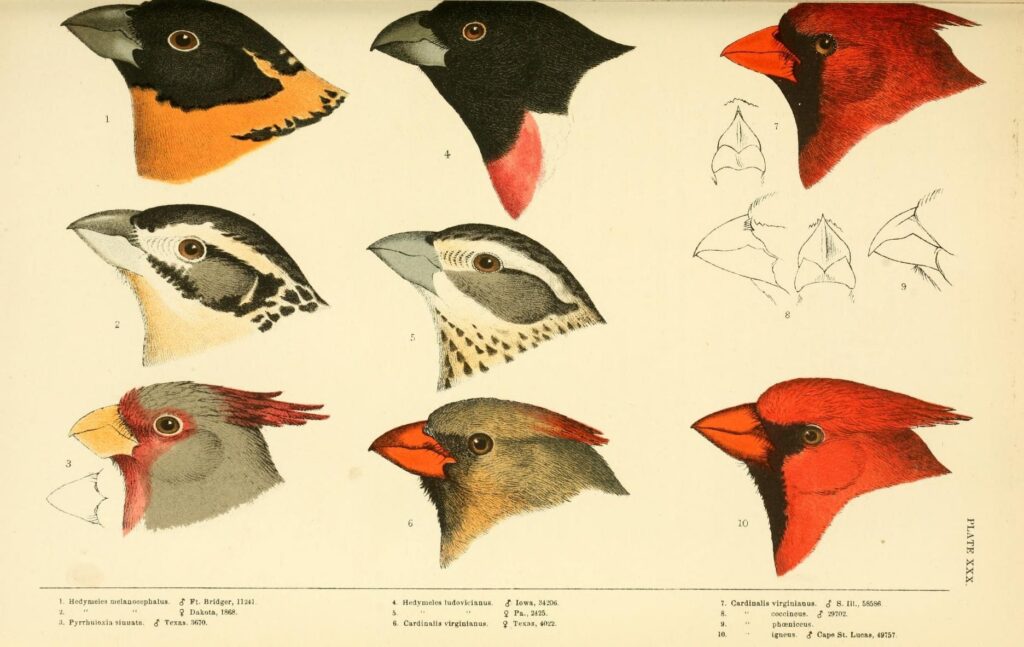
(Baird, Spencer Fullerton; Brewer, T. M.; Ridgway, Robert, Public domain, via Wikimedia Commons)
It is always a mystery, that reverence can come out of murder.
Young Robert Ridgway used to mix up a batch of gunpowder in his father’s pharmacy. He packed it into a rusted rifle recovered from the sunken wreck of a river steamer, and he and his father went hunting in the woods around Olney, Illinois. Flashes of red and yellow against a blackbird’s glossy wing might have caught his eye, then a robin’s flushed breast, bright against blue sky. After the manly explosions and the gathering up of soft, inert bodies, still warm, Robert returned to the pharmacy—this time to mix paint colors. Believing that ornithologists had all died out like auks and he was the only one interested in birds, Robert was determined to capture what he saw in midair, learn the birds’ names, describe them.
Like people, the birds were a study in contrasts: soft gray doves, modest and unassuming; common pigeons with their unexpected, iridescent bling. High pure song; raucous cawing. Gliding on air currents or hopping, nervous, on legs like wire; doing carefree loop-de-loops or making frantic jabs at earthworms. With the same cool fascination that led Beatrix Potter to scoop the innards from dead bunnies and stuff them with precision, Robert turned his scientific observations into art.
At thirteen, he wrote to the Commissioner of Patents, enclosing a drawing and urgently asking what bird it was. His letter was forwarded to Spencer Fullerton Baird at the Smithsonian, who replied that this was a purple finch, praised Robert’s artistic abilities, and instructed him to learn and use the scientific names of birds in any future correspondence.
They did indeed continue to correspond, and three years later, Robert was invited to join a survey expedition out west. Over the next two years, he collected 1,522 bird nests, eggs, and skins and observed 262 species. Back home, he wrote and illustrated for A History of North American Birds, coauthored by Baird. In 1871, he met the teenage daughter of one of the History’s engravers. He courted her for four years, and they married when she turned eighteen. By then he had been formally hired by the Smithsonian; he was given living quarters atop the south tower. The bird collection was in the east wing at the time, with tiny, delicate bird skins sealed inside tin herbarium cases and larger skins laying in walnut cabinets’ glass-topped drawers.
In 1880, he became the Smithsonian’s first full-time curator of birds—and held the position for half a century, until his death. In 1886, he wrote A Nomenclature of Colors for Naturalists, diagramming birds—the abdomen, pure white on a young swallow; the crown, tufted pure red on a cardinal; the upper tail coverts, the tertial and secondary wing feathers—and categorizing 186 colors. After publication, he grew even more serious, studying the color theory Milton Bradley had developed and applied to his bright board games and crayons and color wheel (spin it and watch the colors mix).
In 1912, Ridgway grew exasperated with a committee’s interest in commercial applications for what he saw as a pure naturalistic reference guide, so he abandoned his partnership with the Smithsonian and self-published Color Standards and Color Nomenclature, this time naming 1,115 colors. Arbitrary, fanciful color names annoyed him (it is a mercy he never had to buy nail polish) so instead of elephant’s breath, London smoke, or new old rose, he gave us peacock blue, dark turtle green, bone brown.
Shy as a sparrow, he traveled reluctantly, because his job required it. He agreed to assume the presidency of the American Ornithologists’ Union on the condition that he never be forced to preside over a public meeting. A tenacious scholar, he never paused for college, yet the Smithsonian titled him Professor and, years later, he received an honorary graduate degree.
Robert and Julia had one son, whom they named Audubon. At twenty-four, just after accepting a position at the Field Museum in Chicago, Audubon fell ill with pneumonia and died. Frozen by grief, Julia’s body turned fragile, ready to shatter at any moment. Robert’s nerves stayed raw. In 1913, the Ridgways took shelter back in Olney, where Robert could find enough quiet and calm to work on the final volumes of The Birds of North and Middle America.
Julia died in 1927, doubling Robert’s grief. For two more years, until his death in 1929, he continued to work on his 6,000-page, eleven-volume magnum opus, The Birds of North and Middle America. Another Smithsonian curator finished the last three volumes.
Today, naturalists use his colors, as do mushroom scientists and chemists and stamp collectors. The first Pantone color chart, printed in 1963, evolved from Ridgway’s work. When printers and designers pore over those swatches, they may be choosing—without realizing it—the electric blue of an indigo bunting or the soft green of a warbler.
Ridgway devoted his life to creatures that soared and glided, trotting after them through mud and storms, ever vigilant, and detailing and comparing and never giving up. No one has described as many North American bird species, let alone illustrated them himself. He was the first to describe the hood mockingbird, the Espanola cactus finch, and the medium tree finch. The buff collared nightjar, the turquoise cotinga, a Caribbean osprey, and a hawk all carry Ridgway in their formal scientific names, as does the genus of the Aztec thrush. And a surprising number of people, still living, are interested.
Read more by Jeannette Cooperman here.
